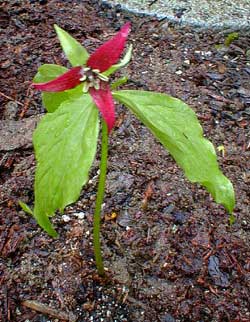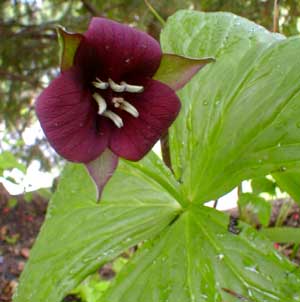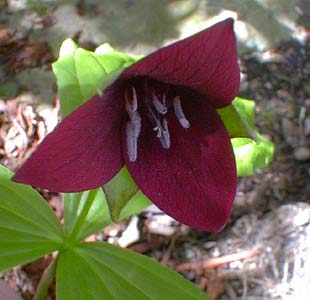
Trillium erectum,
the Red Wake-robin
"Where will they stop, those breathing Powers,
The Spirits of the new-born flowers?
They wander with the breeze, they wind
Where'er the streams a passage find."
-William Wordsworth
(1770-1850)
(1770-1850)
Trillium erectum is variously known by the common names Red Trillium, Purple Trillium, & because its flower tends to dangle, Nodding Wake-robin.
In the northeast it is sometimes called Birthroot or by a polite mispronunciation Beth Root, or Bathroot, Bathwort, or Bath Lily, evidently because it was once used in the bath as a "uterine tonic" or douche, & was used by Native American midwives during parturition to restrict the possibility of hemorrage.
It has even been called "Nosebleed Trillium" from a belief that it can either stop nosebleeds with its extract's astringent qualities, or cause a nosebleed by its pungeant odor. Several other folknames reflect widespread beliefs in the root as medicinal., including Snakebite Plant, Cough Root, & Indian Balm.
 Because the flowers have a pungency occasionally described as like that of a wet dog, the Red Trillium has also been called by such unlovely epithets as Stinking Benjamin or Stinking Willie, or even just "Ill-Scented Trillium." This is not a universal trait, as many blooms have no odor; & at its worst, you have to get your nose awfully close to smell it.
Because the flowers have a pungency occasionally described as like that of a wet dog, the Red Trillium has also been called by such unlovely epithets as Stinking Benjamin or Stinking Willie, or even just "Ill-Scented Trillium." This is not a universal trait, as many blooms have no odor; & at its worst, you have to get your nose awfully close to smell it.Other names have largely fallen out of use, including Indian Shamrock, Squawroot, Lamb's Quarters, Ground Lily, Wood Lily, Daffy Downlily, Jew's Harp Plant, Milk Ipecac, Pariswort, Rattlesnake Root, Bumblebee Root, Truelove, or Three-leafed Nightshade, some of which are names shared with other species of trilliums.
It acquired so many names because it is so widespread in the eastern United States, from the midwest to Alabama to Canada.
 We have two T. erectum in a shade garden we call Pulpit Hill because it is dominated by sundry species of jack-in-the-pulpits. But when the pulpits are still just horns beginning to poke out of the ground, the trilliums area already in full leaf beginning in March, with the earliest flowering in April.
We have two T. erectum in a shade garden we call Pulpit Hill because it is dominated by sundry species of jack-in-the-pulpits. But when the pulpits are still just horns beginning to poke out of the ground, the trilliums area already in full leaf beginning in March, with the earliest flowering in April.Our Red Wake-robins were cultivated from stock selected for the brilliant color. These originated in Missouri, & were grown from seed by one our Northwest nurseries that specializes in shade plants & native species.
The first photo above was taken in early April (2003). It is a young plant & produced the slim-petalled flowers its first year. The second photo is the same plant one year later, when it got much larger both for leaf & flower, as shown in the second photo. The tips of its petals curled backward in quite a charming manner, but a second clump of T. erectum does not curl its petals in this manner. The second clump is a slightly larger specimen because one year older was further back in the shade. In 2003 it had two stems & trios of leaves, but its flowers were still just green buds when the newer specimen produced its first flower of that year. In late April the larger of two buds in the second specimen bloomed with its face quite nodded, having fatter stubbier petals of an even deeper red-maroon. This one is shown in the third photo. A year later it produced three stems but still only two flowers.
Each year it should get just a tiny bit bigger, if never disturbed, until it is a nice full clump of triple-leafed stems & dark maroon-red flowers, one per stem. But even when young & humble in the shadows of a shade garden, it is a darling perennial.
These bloom most strongly April & May, but is capable of flowering from March through June, so long as they experience cool even temperatures & remain moist. The three-petalled blooms are two to three inches wide, with considerable color variation across its extensive range. At their best these little flowers are quite a startling maroon-red, as is the case with our specimens, but others are known to range through white, pinkish, or mauve. Each flower turns into a small red berry.